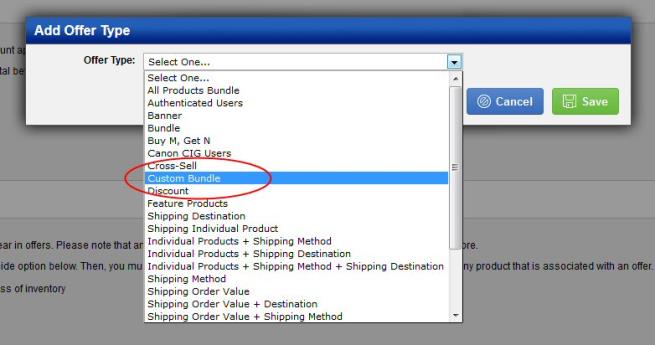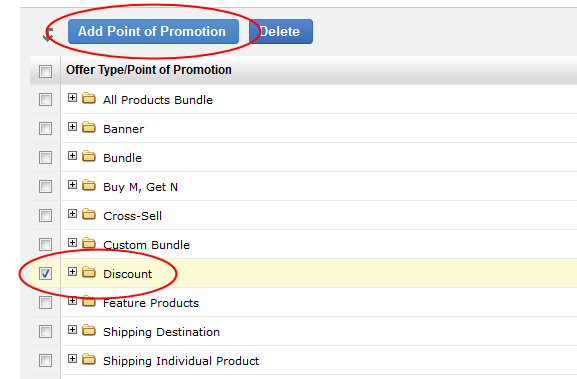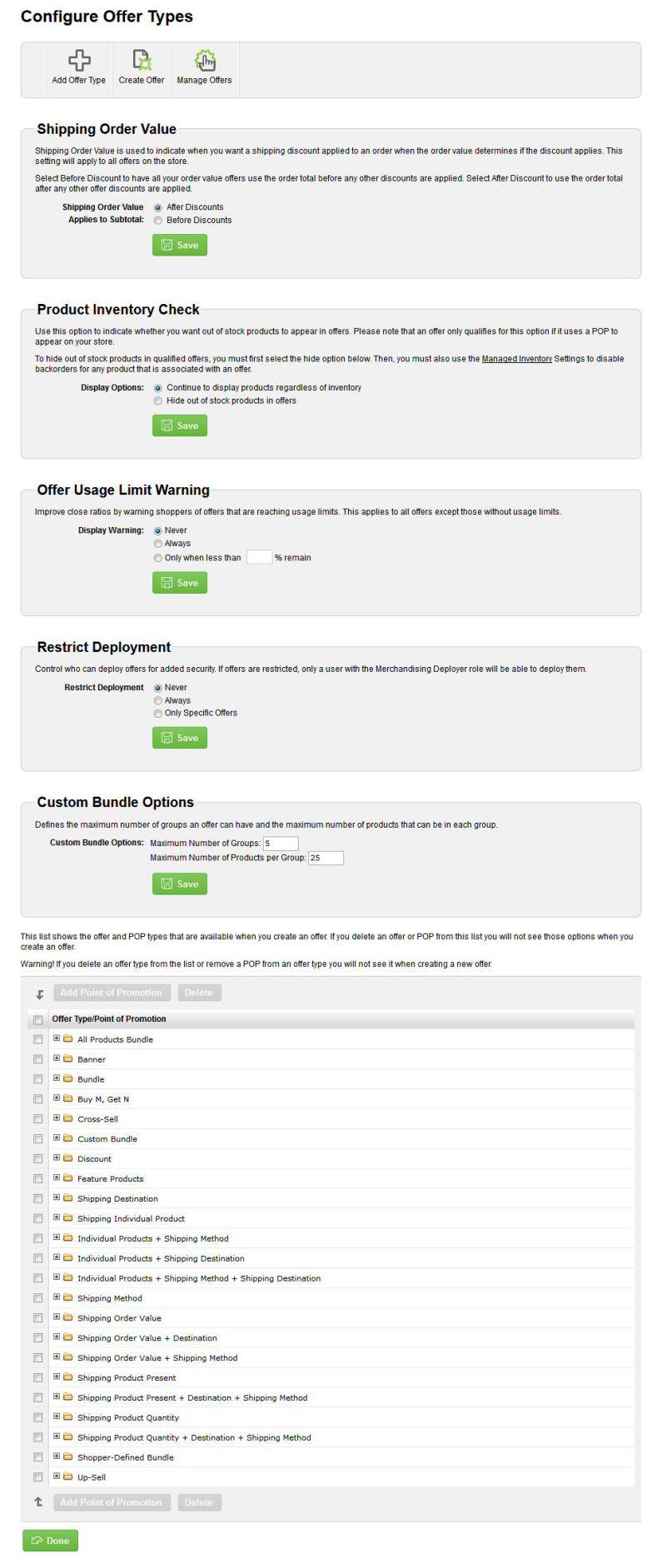You must set up the offer and POP combinations for your store before you can create an offer of a specific type. There are also other settings and options you can define for offers such as how you want "shipping order value" offers to behave, whether you want inventory checks for offers that use POPs, and whether you want to warn shoppers that the offer they are using has a usage limit.
Opening the Configure Offer Types Page
| Required Role: Site ManagerA user role that provides access to various site-level settings. Search this file for the "user role definitions" topic for more information. |
- On the Administration menu, select Site, and click Configure Offer Types. The Configure Offer Types page appears.
 See example.
See example.
Setting Shipping Order Value Discounts
Shipping order value offers are used to provide a promotion or discount when the total order value reaches or exceeds a certain amount that you set when you create the offer. However, because multiple offers can be applied to the same order you may want to control whether order value offers use the order total calculated before or after any other discounts are applied.
Note: The Shipping Order Value area will only appear if the Shipping Order Value offer type has been added to your store. See Adding Offer Types and Associating POPs with Offer Types below for instructions on how to add the Shipping Order Value offer type.

- In the Shipping Order Value area, select After Discounts or Before Discounts. The selection you make depends on whether you want a shipping discount applied to an order based on the total before other discounts are added, or after other discounts are added.
- Click Save.
Setting Product Inventory Check
The Product Inventory Check setting is used to indicate whether you want out of stock products to appear in offers. The inventory check does not work with offers that do not discount or apply to a specific product. This means that an offer that discounts an entire order or the shipping costs for an entire order regardless of the products purchased cannot do an inventory check. The inventory check also does not work with candy rack POPs.

- In the Product Inventory Check area, for the Display Options option, select whether you want to do an inventory check for products in offers that use a POP to appear on your store:
- Select Continue to display products regardless of inventory if you want products to appear in offers that use POPs
- Select Hide out of stock products in offers if you want products that are found to be out of stock to be hidden in offers that use POPs. Keep in mind that you may also want to use Managed Inventory Settings to disable backorders for physical products so that shoppers cannot still place orders for out of stock options.
- Click Save.
Setting Offer Usage Limit Warning
The Offer Usage Limit Warning setting allows you to notify shoppers who have triggered an offer that is nearing its usage limit that they may miss out on the offer if they don't act quickly to redeem it.

- In the Offer Usage Limit Warning area, for the Display Warning option, select whether you want to warn shoppers that the offer they are using has a usage limit. Usage limits can be limited by individual shoppers, or by total usage on your store.
- Select Never if you never want offer usage warnings to appear to shoppers.
- Select Always if you always want offer usage warnings to appear to shoppers.
- Select Only when less than % remain if you want to warn shoppers of usage limits when a certain percent of the usage limit has been reached. Make sure you enter the percentage you want to trigger warnings in the field. For example, enter "50" if you want shoppers to be warned when 50% of the offer usage has been reached.
- Click Save.
The Restrict Deployment setting allows you to specify if offers can be marked as "sensitive" and require that someone with the Merchandising Deploy Manager role deploy the offer (internal users will also be able to deploy offers with restrict deployment option set. Users with the Merchandising Manager role will still be able to create offers (and mark them as sensitive) but offers marked as sensitive can only be deployed by users with the Merchandising Deploy Manager role.
Note to Internal Users: Internal users can always deploy a sensitive offer even if they do not have the Merchandising Deploy Manager role.

- In the Restrict Deployment area, select how you want to restrict deployment for offers:
- Select Never if you never want offers to be able to be marked as sensitive or restricted for deployment in any way.
- Select Always if you want every offer to be marked as sensitive and require that a user with the Merchandising Deploy Manager role deploy them (no one else besides a user with that role or a Digital River internal user will be able to deploy offers). This includes offers that were created in the past but that are changed (and therefore need to be deployed again) after you select and save this setting.
- Select Only Specific Offers if you want to mark offers as sensitive on a one-by-one basis. If you select this option, some options will appear in the offer wizard to indicate how the offer should be marked as sensitive. This means that some offers on your site can be "sensitive" while others may not, and the choice to mark as offer as sensitive will be with the Merchandising Manager that creates the offer.
- Click Save.
Setting Custom Bundle Options
The Custom Bundle settings allow you to define the maximum number of groups that can be created for a custom bundle, as well as the maximum number of products that can be added to each group.

- In the Custom Bundle Options area, in the Maximum Number of Groups field, enter the maximum number of groups you want to be able to be created for a custom bundle. The groups in a custom bundle are used to organize products from which the shopper can purchase.
- In the Maximum Number of Products per Group field, enter the maximum number of products that you want to be allowed per group. Keep in mind that the more products you have the more it may affect the visual layout of the custom bundle on your store or affect performance of the page.
- Click Save.
Adding Offer Types and Associating POPs with Offer Types
To create an offer of a certain type, the offer must first be added to your site. To use a POP with a specific offer type, that POP must be associated with the offer type.
Note: To use the "related products" token in offers, associate the "RelatedProductsToken" POP with the cross-sell offer type.
- To add an offer type to your site:
- In the taskbar, click Add Offer Type.

- In the Add Offer Type window that appears, select the offer you want to add to your site from the list and click Save. The list of offers and POPs refreshes to show the new offer you just added.

- In the taskbar, click Add Offer Type.
- To associate a POP with an offer type on your site:
- In the list of offers at the bottom of the page, click the check box for the offer you want to configure and click Add Point of Promotion.

- In the Add Point of Promotion window that appears, select the POP that you want to associate with the offer and click Save.
Note: You will only be able to associate a POP with an offer type if the POP can be used with the offer type. Keep in mind that some offers require a specific POP.
- In the list of offers at the bottom of the page, click the check box for the offer you want to configure and click Add Point of Promotion.
Deleting and Removing Offer and POPs
- To delete an offer type from appearing for your company, click the check box for the offer you want to remove and click Delete. When the page refreshes the list of offers updates to show the deletion. Keep in mind that you can add the offer type to your site again if you find you want it on your site.
- To remove the association of a POP to an offer type, first locate the POP you want to delete (click the + next to an offer type see which POPs are associated with the offer). Then, select the POP you want to remove from the offer type and click Delete. When the page refreshes the list updates to show the deletion.
